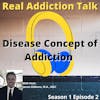Disease Concept of Addiction
James Gibbons, M.A., IADC
When you think about diseases, the first things that come to mind our: cancer, AIDS, heart, etc. However, once somebody mentions that addiction is a disease, you begin to stir up a debate. In most scientific articles, it’s believed that only 51% of Americans believe that addiction is a disease. The other 49% believe that it’s a choice. So, how do we actually determine that addiction is a disease? The first thing we need to do is understand what a disease is. According to medical terms, a disease is defined as:
”A disorder of structure or function in a human, animal, or plant, especially one that produces specific signs or symptoms or that affects a specific location and is not simply a direct result of physical injury”. (Oxford Dictionary).
Seems simple enough, right? The main point of that definition is “signs and symptoms”. But that is just one out of the four main focal points that classify something to be considered a disease. The other four are:
- Progressive
- Chronic
- Incurable
- Signs/symptoms
So, if we were to look at addiction, we need to ask ourselves, “does these four main points involved with addiction: progressive (yes, it progresses over time), chronic (yes, it lasts forever), incurable (yes, there is no cure), and signs/symptoms (yes, several of them).
Some examples of signs/symptoms of addiction include: loss of job, legal issues, health issues, increased mental health issues, relationship issues, tolerance goes up, cravings, withdrawal, etc. All diseases also go through three different stages: early, middle, late. The following photo displays what signs/symptoms an individual may experience in each of the three stages:
Three stages of disease and the signs/symptoms included in each stage
You’ll notice that as each stage increases, the signs/symptoms also progress. It’s also between the early and middle stage where the disease becomes triggered. It’s different for everybody, but once we cross that threshold between the early and middle stage, we trigger the disease, and now we can only learn to manage it. The issue at this point becomes once we cross this threshold and have a period of sobriety, we begin to feel confident, and we begin to think “Oh, I can have just one”. This way of thinking may last for a couple of weeks, but it’s just a matter of time until the individual goes right back into the middle stage of the disease. So, if there is one thing to get out of this, it’s the fact that once the disease of addiction is triggered, we can’t go back into the early stage and stay there after a period of sobriety.
Example of going back to the middle stage after “one use”.
There are two major factors that contribute to triggering this disease: genetics and environmental factors. Starting with the genetic factor, if one of the parents has an addiction, the chances of the offspring developing an addiction is 50%, for both parents, it’s 85%. Why not 100%? Because not everybody develops the disease. Just like those that eat too much sugar will never develop diabete, those who get HIV won’t develop AIDS, or those who smoke cigarettes won’t develop lung cancer. Those who have the genetic tendency to develop the disease are the ones at risk to get it. The second factor, environmental, involves several different factors: growing up in a broken home, having parents that use around you at a young age, the community you grow up in, and trauma. Trauma as a child is statistically the biggest environmental factor because what tends to happen is that a traumatic event occurs at a young age, the child never talks about it, finds alcohol (or other substances) and realizes that he/she feels good for a moment, and at some point, the disease becomes triggered.
If you are familiar with addiction or have gone through it yourself, I’m sure you have heard this classic question, ”Why can’t you just stop?”. Well, it’s become a our mind changes in fundamental ways after prolonged use. It becomes the number one thing that we yearn for, it becomes our top “survival” aspect in our lives. There was an interesting quote that I read, and I can’t remember where I got it from, but it went something like this:
And what a powerful quote that is...and how true. Nobody would choose to become addicted to a substance just as nobody would choose to get cancer. It’s just that due to needing the substance, experiencing the cravings, severe mental health, lack of coping skills, one is unable to properly manage the disease and get recovered. This is where it’s vital to understand the disease of addiction, not just within our families, but within our communities. We need to change the way we view addiction and re-thing how we use some of those terms that get swung around. For instance, there is a huge difference between a lapse and relapse. A lapse is when an individual uses one time but is working the program. He/she becomes honest about their use, gets back on track, figures out a game plan, and follows their action plan back to sobriety. A relapse is when an individual goes right back to their old behaviors of using. Knowing the difference between these two words could save somebody‘s life for years to come. Understanding that it’s only a lapse can help the individual from preventing a full-blown relapse.
There was a study done in the 1970’s where they would put a mouse inside of a cage, by itself, and they would give the mouse two bottles: one full of water and the other full of cocaine. What they found was that the mouse would almost always choose the cocaine and die rather quickly. However, if they put the mouse in a cage with other mice, what they found was that the mice would hardly ever touch the cocaine, in fact, if they did, they would never over do it. The reason? It’s because they felt a special connection with the other mice in the cage and didn’t feel the need to use cocaine. Millions of years of evolution has shown us that we need compassion, bonds, and support in our lives. If we don’t have that, we’ll find something that will fill that void, and most times, it’s a drug that we will bond with.
If you are familiar with mice, you’ll notice that once the light comes on, they tend to dart straight into darkness. This is because if they are caught in the light, they have an increased chance of getting killed by another predator. However, there was another study that was done where they would give a mouse cocaine and what they found was that after a small period of time, the mouse wouldn’t care if it was light or dark out, it would risk its life to out after the cocaine. That’s the power of addiction, the understanding that one is willing to risk his/her life for a drug, and it’s all too familiar in our culture.
When addiction was considered a disease in the 1950’s, people with addictions had the opportunity to get professional help. Since the 1950’s, treatment centers and the way how we treat those with an addiction has changed dramatically. Involving the clients with their own treatment plans, not stigmatizing them for continued use, and developing a professional relationship with each client. The longer one stays in treatment, the better chances they have with recovery. There is a quote that I would like to conclude with, and I’m not sure who said it, but it shows that those with an addiction have hope and have the understanding that recovery is possible:
“We are not responsible for our disease, but we are responsible for our recovery”.


















